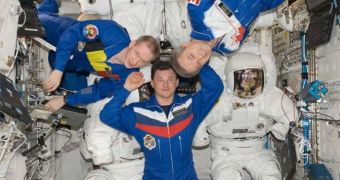Three astronauts left the International Space Station (ISS) on Monday, letting only two members of the former Expedition 21 crew take care of the orbital facility. A Russian, a Canadian and a Belgian took with them one of the Soyuz capsules docked to the station at all times, and are headed for a landing on the steppes of Kazakhstan today, at around 2:16 am EST (07:16 GMT). Each of the three astronauts that left yesterday, RosCosmos expert and former ISS flight engineer Roman Romanenko, Canadian Space Agency (CSA) astronaut Bob Thirsk and former Expedition 21 commander, ESA's Frank DeWinne (from Belgium), concluded their allotted six-month stays on the laboratory.
Though it may seem like a paradox, as soon as the Soyuz space capsule departed the ISS, and only two astronauts remained, Expedition 21 officially ended, and Expedition 22 began. Only Commander Jeffrey N. Williams (NASA) and flight engineer Maksim Surayev (RosCosmos) are left on the station now, and they will be all alone until the end of December, when the rest of the crew joins them. The other three astronauts are scheduled to be delivered aboard the Soyuz TMA-17 spacecraft, which will mark the 104th flight of this type of capsule, Space reports.
RosCosmos cosmonaut Oleg Kotov will be the Commander of Expedition 22, and he will be joined in the new flight by NASA astronaut Timothy Creamer, and JAXA astronaut Soichi Noguchi. The latter will be the second long-term space flier that the Japanese Space Agency will have on the outpost, after Koichi Wakata, who stayed on the station for Expeditions 18, 19 and 20. The three are scheduled to be launched from the Baikonur Cosmodrome, in Kazakhstan, on December 21.
During the time the former Expedition 21 members spent on the station, a lot of important new additions were made to the outpost, which is now about 86 percent complete. A new Russian docking module, named Poisk, was added, bringing the total number of Russian docking ports on the station to four. A fresh science platform was also installed on the Japanese Kibo module, one of the largest laboratories aboard the ISS. Their stay saw the arrival of the first HTV, the new unmanned cargo ship designed and constructed by JAXA that will play an important role in supplying the station.
"I miss my family most of all, of course. I am already dreaming of those first hugs when I see my family in Moscow. After that is nature. I miss the wind; I miss the sunlight, the smell of flowers, and freshly cut grass,” Thirsk stated last week. “I really appreciate my friends. We had a very good time together, we had a very good experience during our six-month flight,” Romanenko said of the astronauts with whom he shared all of his time on the station for the past few months. “The most exciting moment was the arrival of the HTV Japanese cargo vehicle. That went off perfectly,” Thirsk added.

 14 DAY TRIAL //
14 DAY TRIAL //